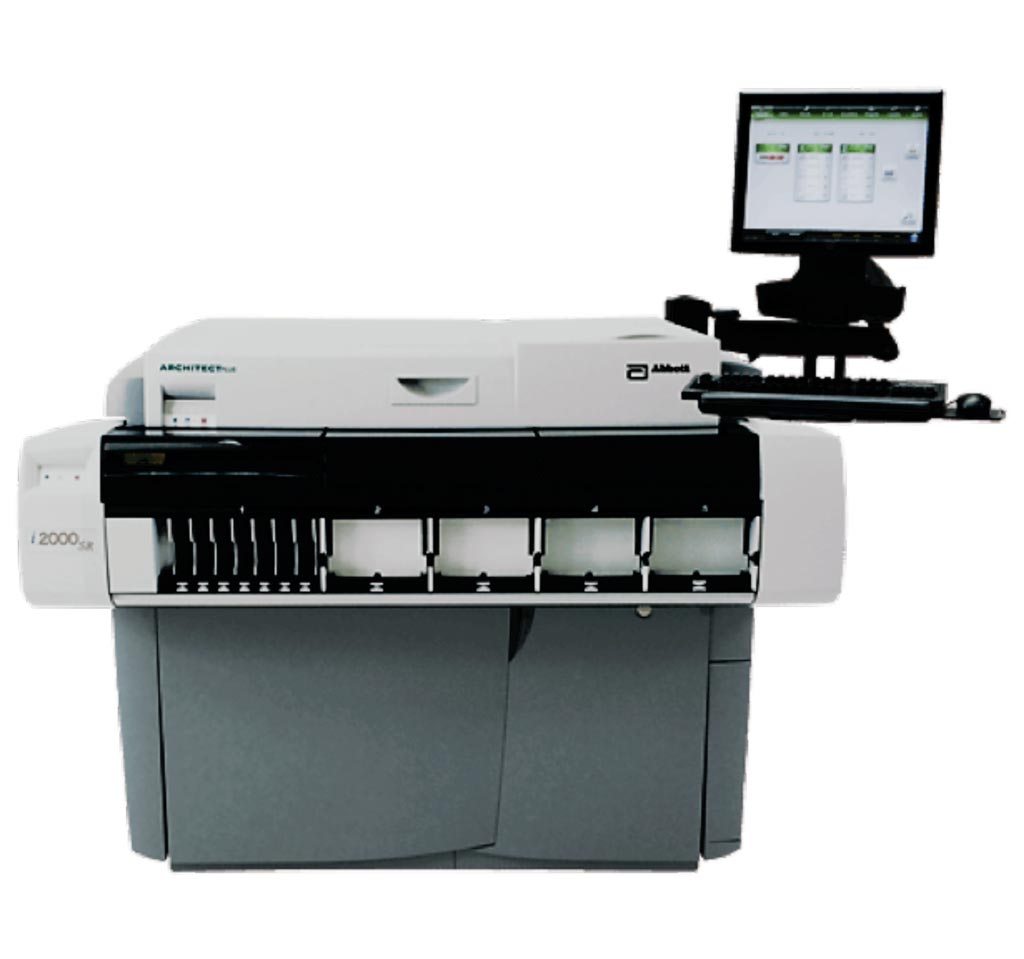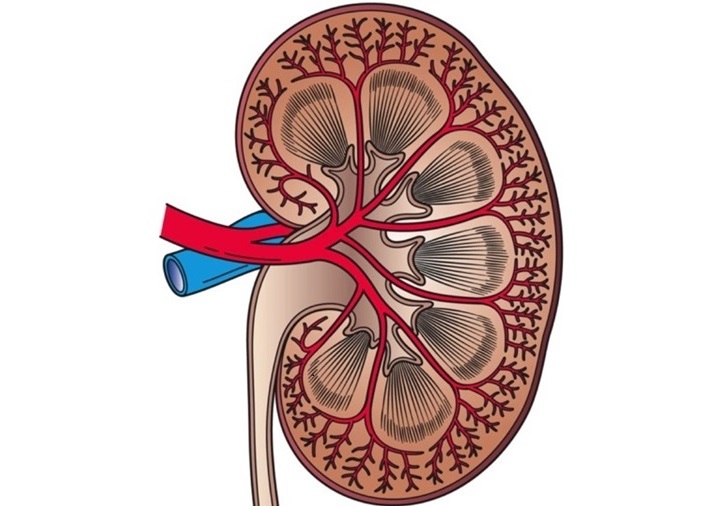Newly Developed Automated Immunoassay Analyzed
|
By LabMedica International staff writers Posted on 29 Nov 2017 |

Image: The ARCHITECT i2000SR immunoassay analyzer (Photo courtesy of Abbott).
Dipeptidyl peptidase-4 (DPP-4) may be a suitable biomarker to identify people with severe asthma who have greater activation of the interleukin-13 (IL-13) pathway and may therefore benefit from IL-13-targeted treatments.
Increased IL-13 messenger RNA (mRNA) expression and protein concentration in bronchial biopsies, sputum and bronchoalveolar lavage fluid from patients with asthma, compared with healthy individuals, supports a role for IL-13 in the pathophysiology of some types of asthma.
A team of scientists collaborating with those at the Abbott Laboratories (Abbott Park, IL, USA) obtained serum samples from healthy volunteers and from subjects with asthma and type 1 diabetes. They used in DPP-4 concentration assessments, samples obtained from a Phase IIb study of tralokinumab in subjects with severe uncontrolled asthma receiving concomitant high-dose fluticasone and salmeterol. Additional samples, collected for a pre-analytical in-house study to confirm specimen-handling procedures, were provided by consenting volunteers with self-reported asthma.
The team assessed assay performance, utilizing analyses of precision, linearity and sensitivity; interference from common endogenous assay interferents, and from asthma and anti-diabetic medications, were also assessed. The new automated IUO DPP-4 immunoassay was performed on Abbott’s ARCHITECT i System. The immunoassay measurement of DPP-4 has a range from 109 ng/mL to 580 ng/mL. The assay is fully automated with a throughput of 200 tests per hour.
The investigators reported that the total precision of DPP-4 concentration measurement, determined using percentage coefficient of variation, was ≤5% over 20 days. Dilution analysis yielded linear results from 30 to 1,305 ng/mL; the limit of quantitation was 19.2 ng/mL. No notable endogenous or drug interferences were observed at the expected therapeutic concentration. Median DPP-4 concentrations in healthy volunteers and subjects with asthma or Type 1 diabetes were assessed, with concentrations remaining similar in subjects with diabetes and asthma across different demographics.
The authors concluded that their analyses indicate that the ARCHITECT DPP-4 immunoassay is a reliable and robust method for measuring serum DPP-4 concentration. The assay is currently being applied to assess the clinical utility of DPP-4 as a predictive biomarker in Phase III studies of tralokinumab in subjects with uncontrolled asthma. The study was published online on October 20, 2017, in the journal Practical Laboratory Medicine.
Increased IL-13 messenger RNA (mRNA) expression and protein concentration in bronchial biopsies, sputum and bronchoalveolar lavage fluid from patients with asthma, compared with healthy individuals, supports a role for IL-13 in the pathophysiology of some types of asthma.
A team of scientists collaborating with those at the Abbott Laboratories (Abbott Park, IL, USA) obtained serum samples from healthy volunteers and from subjects with asthma and type 1 diabetes. They used in DPP-4 concentration assessments, samples obtained from a Phase IIb study of tralokinumab in subjects with severe uncontrolled asthma receiving concomitant high-dose fluticasone and salmeterol. Additional samples, collected for a pre-analytical in-house study to confirm specimen-handling procedures, were provided by consenting volunteers with self-reported asthma.
The team assessed assay performance, utilizing analyses of precision, linearity and sensitivity; interference from common endogenous assay interferents, and from asthma and anti-diabetic medications, were also assessed. The new automated IUO DPP-4 immunoassay was performed on Abbott’s ARCHITECT i System. The immunoassay measurement of DPP-4 has a range from 109 ng/mL to 580 ng/mL. The assay is fully automated with a throughput of 200 tests per hour.
The investigators reported that the total precision of DPP-4 concentration measurement, determined using percentage coefficient of variation, was ≤5% over 20 days. Dilution analysis yielded linear results from 30 to 1,305 ng/mL; the limit of quantitation was 19.2 ng/mL. No notable endogenous or drug interferences were observed at the expected therapeutic concentration. Median DPP-4 concentrations in healthy volunteers and subjects with asthma or Type 1 diabetes were assessed, with concentrations remaining similar in subjects with diabetes and asthma across different demographics.
The authors concluded that their analyses indicate that the ARCHITECT DPP-4 immunoassay is a reliable and robust method for measuring serum DPP-4 concentration. The assay is currently being applied to assess the clinical utility of DPP-4 as a predictive biomarker in Phase III studies of tralokinumab in subjects with uncontrolled asthma. The study was published online on October 20, 2017, in the journal Practical Laboratory Medicine.
Latest Clinical Chem. News
- POC Saliva Testing Device Predicts Heart Failure in 15 Minutes

- Screening Tool Detects Multiple Health Conditions from Single Blood Drop
- Integrated Chemistry and Immunoassay Analyzer with Extensive Assay Menu Offers Flexibility, Scalability and Data Commutability
- Rapid Drug Test to Improve Treatment for Patients Presenting to Hospital
- AI Model Detects Cancer at Lightning Speed through Sugar Analyses
- First-Ever Blood-Powered Chip Offers Real-Time Health Monitoring
- New ADLM Guidance Provides Expert Recommendations on Clinical Testing For Respiratory Viral Infections
- 3D Printed Point-Of-Care Mass Spectrometer Outperforms State-Of-The-Art Models
- POC Biomedical Test Spins Water Droplet Using Sound Waves for Cancer Detection
- Highly Reliable Cell-Based Assay Enables Accurate Diagnosis of Endocrine Diseases
- New Blood Testing Method Detects Potent Opioids in Under Three Minutes
- Wireless Hepatitis B Test Kit Completes Screening and Data Collection in One Step
- Pain-Free, Low-Cost, Sensitive, Radiation-Free Device Detects Breast Cancer in Urine
- Spit Test Detects Breast Cancer in Five Seconds
- Electrochemical Sensors with Next-Generation Coating Advances Precision Diagnostics at POC
- First-Of-Its-Kind Handheld Device Accurately Detects Fentanyl in Urine within Seconds
Channels
Clinical Chemistry
view channel.jpg)
POC Saliva Testing Device Predicts Heart Failure in 15 Minutes
Heart failure is a serious condition where the heart muscle is unable to pump sufficient oxygen-rich blood throughout the body. It ranks as a major cause of death globally and is particularly fatal for... Read more
Screening Tool Detects Multiple Health Conditions from Single Blood Drop
Infrared spectroscopy, a method using infrared light to study the molecular composition of substances, has been a foundational tool in chemistry for decades, functioning similarly to a molecular fingerprinting... Read more
Integrated Chemistry and Immunoassay Analyzer with Extensive Assay Menu Offers Flexibility, Scalability and Data Commutability
As global healthcare systems increasingly shift towards networked laboratory operational models to enhance efficiency and patient access, there is a greater need for innovative solutions tailored to the... Read moreMolecular Diagnostics
view channel
cfDNA Testing Reduces Pregnancy Risks
The highly anticipated emergence of "precision medicine" promises customized technologies that can benefit individuals while potentially lowering healthcare costs. Now, new research suggests that pregnancy... Read more
Non-Invasive Biosensor Facilitates Early Kidney Disease Detection
Traditionally, kidney function has been assessed by measuring blood creatinine levels, which reflect muscle breakdown. Elevated creatinine levels may indicate that the kidneys are not effectively filtering waste.... Read moreHematology
view channel
Next Gen CBC and Sepsis Diagnostic System Targets Faster, Earlier, Easier Results
Every hour is critical in protecting patients from infections, yet there are currently limited tools to assist in early diagnosis before patients reach a hospital. The complete blood count (CBC) is a common... Read more
Newly Discovered Blood Group System to Help Identify and Treat Rare Patients
The AnWj blood group antigen, a surface marker discovered in 1972, has remained a mystery regarding its genetic origin—until now. The most common cause of being AnWj-negative is linked to hematological... Read more
Blood Platelet Score Detects Previously Unmeasured Risk of Heart Attack and Stroke
Platelets, which are cell fragments circulating in the blood, play a critical role in clot formation to stop bleeding. However, in some individuals, platelets can become "hyperreactive," leading to excessive... Read moreMicrobiology
view channel
High-Accuracy Bedside Test to Diagnose Periprosthetic Joint Infection in Five Minutes
Periprosthetic joint infection (PJI) represents a significant global issue that is worsening as the number of joint replacements increases due to aging populations. In the United States alone, the anticipated... Read more_1.jpg)
Innovative Diagnostic Approach for Bacterial Infections to Enable Faster and Effective Treatment
For patients with bacterial infections, timely treatment with the appropriate antibiotics significantly improves their chances of recovery. Current methods for identifying which antibiotics will be effective... Read more
Non-Invasive Stool Test to Diagnose Endometriosis and Help Reduce Disease Progression
Endometriosis, a painful condition impacting nearly 200 million women globally, occurs when tissue similar to the lining of the uterus grows outside its usual location, such as on the intestines or the... Read more
Automated Positive Blood Culture Sample Preparation Platform Designed to Fight Against Sepsis and AMR
Delayed administration of antibiotics to patients with bloodstream infections significantly increases the risk of morbidity and mortality. For optimal therapeutic outcomes, it is crucial to rapidly identify... Read morePathology
view channel
AI Tool Uses Imaging Data to Detect Less Frequent GI Diseases
Artificial intelligence (AI) is already being utilized in various medical fields, demonstrating significant potential in aiding doctors in diagnosing diseases through imaging data. However, training AI... Read moreAI-Based Method Shows Promise for Pathological Diagnosis of Hereditary Kidney Diseases
Alport syndrome is a hereditary kidney disorder characterized by kidney dysfunction, sensorineural hearing loss, and ocular abnormalities. Early in the disease, patients experience hematuria, which is... Read moreTechnology
view channel
New Noninvasive Methods Detect Lead Exposure Faster, Easier and More Accurately at POC
Exposure to lead can negatively affect health in multiple ways, leading to damage in the brain and central nervous system, delays in development and growth, learning and behavioral issues, problems with... Read more
Noninvasive Test Detects Malaria Without Blood Sample
Malaria remains a significant global health issue, with approximately 250 million cases and over 600,000 deaths reported annually. Nearly half of the world's population is at risk for malaria infection,... Read moreIndustry
view channel
Microbiologics Acquires Diagnostic Quality Controls Manufacturer SensID
Microbiologics (St. Cloud, MN, USA), a biotechnology company specializing in infectious disease reference materials and contract research services, has acquired SensID (Rostock, Germany), a manufacturer... Read more



















_1.jpg)
